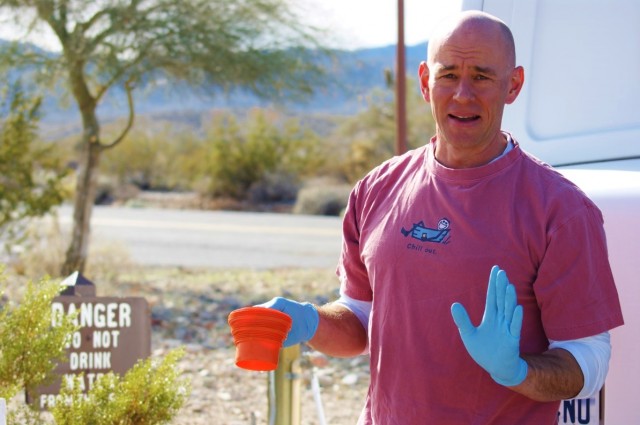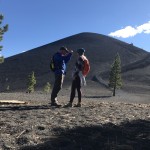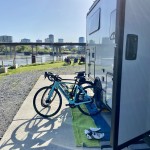This post may contain affiliate links.
James and I still hold full-time jobs. Since we only get so many days off a year, we like to pack as much as we can into every RV trip. Which means we end up having some long…VERY long…driving days. It would be a dream to slowly wind our way like the full-timers do, making leisurely stops to see roadside America along the way. But our vacation days are limited. It’s pretty common for us to drive as much as 12 hours a day; ouch! Much of roadside America goes by in a blur.
Even though James and I have a lot of fun rolling along during our marathon drives, driving for long periods of time without taking breaks can wreak havoc on the body. I don’t know about you, but at the end of a long drive, I can feel totally sapped. It takes all my energy to open the door and assist James in doing the hookups.
Okay, okay, in truth, I just stand there and watch James do the hookups. But even that feels like work.
It makes sense, when you think about it. There are actual physiological changes your body goes through on those long driving days; for both the driver and the passenger. For instance, your inactive lower body muscles send a signal to your brain to slow your metabolism. Your blood circulation slows as well, which leads to all sorts of ill-effects: foggy brain, raised blood sugar levels, fluid pooling in the lower legs, and inflammation, amongst many other joyful things. Google “sitting disease” and you can get all the gory details. So that post-drive sluggishness isn’t just me! It’s an actual “thing.”
To counterbalance it, James and I have a two hour rule. For every two hours we’ve been driving, we have to stop the RV and be active for 15 minutes. During some of those stops, we will simply walk or jog the entire 15 minutes. But, that gets a little boring; plus it neglects our upper bodies. To keep things interesting, we like to come up with “rest stop recharge” workouts. The video link above demonstrates one of them. Yes, you might get quite a few funny looks from fellow rest stop visitors; but it’s worth it. You’ll feel more energized, alert, and ready to hit the road.
Hope you enjoy the video! Just ignore James’ whining…












That was brilliant! Thanks so much for sharing. You made it look so fun, it didn’t seem like enough “work” lol! I’ve always loved tent camping and road trips, but now as a middle aged, sleep deprived mama of a preschooler, stuck under a seatbelt for hours is horrible (which is why I am shopping for a class B or small C). Because of a gene mutation which predisposes my blood to excessive clotting, my wonderful husband would be okay with stopping for a few minutes every two hours, but I am wondering if you guys can offer any ideas on how I might encourage him to join me in those exercises? This sounds silly, but I haven’t even figured out how to do this at home yet. And it looks like so much more fun, doing them with your partner – especially the bottle passes! 😀
You know, I had no idea you were both working full time. You 2 are simply amazing, I’ve been enjoying your videos and learning from you for a couple of years – what a team! John and I are also working full time and building a “high performance” house ourselves – we definitely don’t have time or energy to blog or video. You guys rock! Warmest regards Jennie and John
Awww what a nice comment, thanks Jennie! Yep, this FitRV thing is a part-time gig … keeps it a fun hobby that way instead of pesky work. Best of luck on your high-performance house!!! It’s a ton of work but just think how amazing it’ll be when done! xoxo
Have RVd in the past with tent trailers, 5th wheels and travel trailers. Now exploring motorhome options in our retired old age. Love your reviews. We are drawn to the Travato 59K but wonder about:
1. Are you comfortable with no spare tire?
2. Have read in other blogs that tandem wheels make the rv more stable. Your thoughts?
3. How do you suggest adding storage?
4. Is the small refrigerator and limited water capacity an issue in your opinion?
5. Did you have to adjust headlights when adding summo springs?
thanks Mike and Christel
Hi Mike – let me see if I can help.
1. We are squarely in the “no spare tire” camp. On our last Sprinter, I removed the spare for extra cargo capacity. The 225/75 R16 is either the first or second most common light truck tire in North America. You won’t have trouble finding one if you need one. If you were heading off into the bush, you might want one, but we don’t get *that* remote.
2. Tandem wheels can improve stability on vehicles that need it. The ProMaster is front wheel drive. It has no need for tandem rear wheels. We’ve driven both.
3. Adding storage is tough in a Class B. Generally speaking, they’re all about bringing LESS along with you. That said, when we are going to events and have a lot of gear (and a cat), we have purchased a small, 4×6 trailer that we move our bikes and other supplies to. We hardly notice its there when driving forwards. (Reverse is another story…)
4. No. You get used to working with what you have. We do not find ourselves very limited by water, and not at all limited by our fridge.
5. We did not adjust our headlights when adding Sumo Springs, or when adding VB air suspension. I did adjust and re-aim the headlights once when working with Gordon on our Skid Plate.
Hope this helps!
What about your hamstrings? After having had Achilles tendonitis in BOTH ankles years ago and getting the dreaded ‘Charlie horse,’ I make sure to have a stretch for both tendons in my feet. All it takes is tostand three feet from a wall and lean forward planting one foot back and bending the other leg as you lean forward and hold the position for a few seconds until you get a very good stretch in. Then stand up and do it with the other leg.
Being a bit older, I have learned to stop about every hour just for a pee and stretch break.
Absolutely! James did a calf stretch variation at 2:20 minutes into this video… a forward lunge stretch that’ll hit the calves and Achilles nicely plus he does so dynamically (with movement) since we’re trying to move and get our circulation going, As for hamstrings, the over-under partner water bottle task at 3:20 will work wonders for stretching hamstrings and getting them moving after being idle driving for so long.
And hey… you stopping every hour is even better than every two hours, so you’re doing better than most!!!
James, your a lucky man.
LOL! Mike, I try telling James this every day…
Cool video, thanks for sharing. My wife and I are taking off from Maryland to California in 5 days of driving next week so we’ll use some of your tips!
Maryland to California…well now that’s a bit of a drive, LOL! Just remember, the vacation doesn’t begin at the destination, let the drive be part of the vacation, too. Slow down, see some sights along the way, and most definitely get out of the RV and move. Safe travels to you!